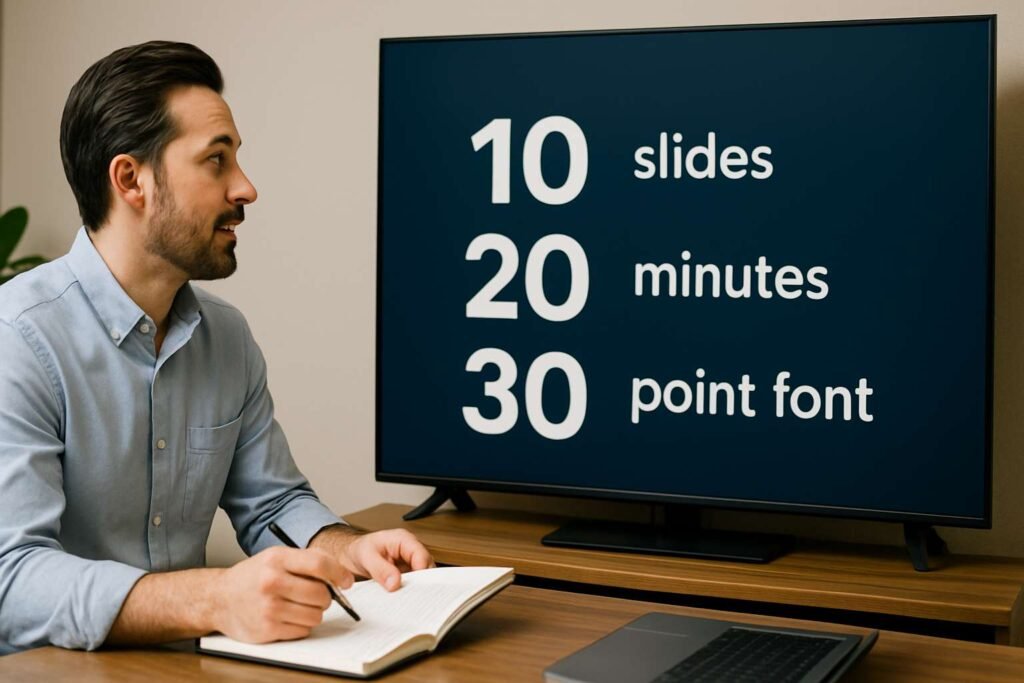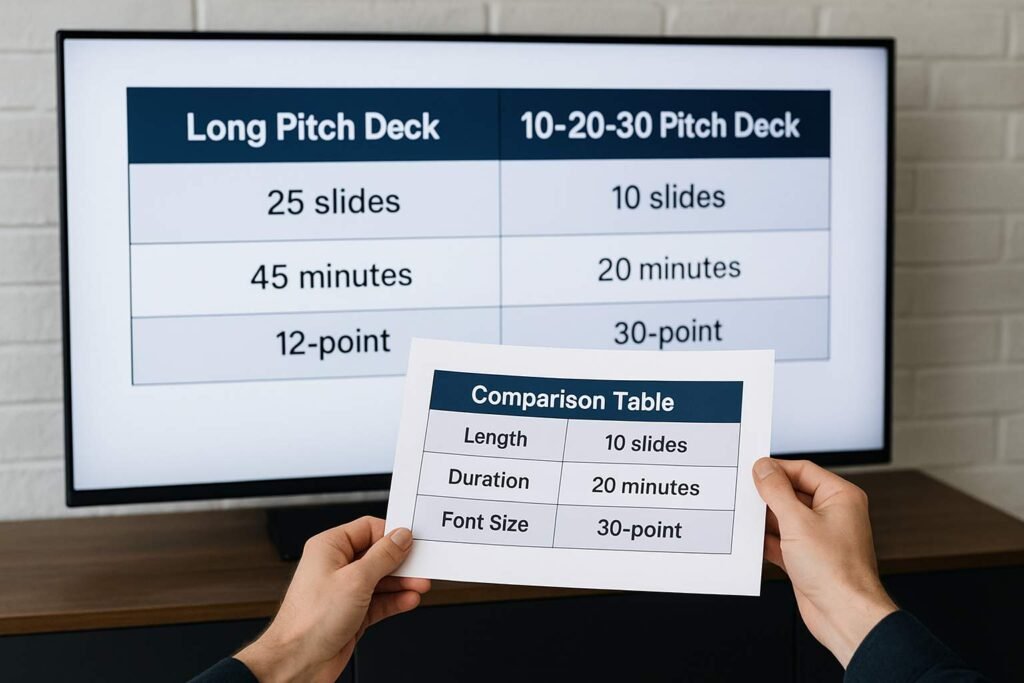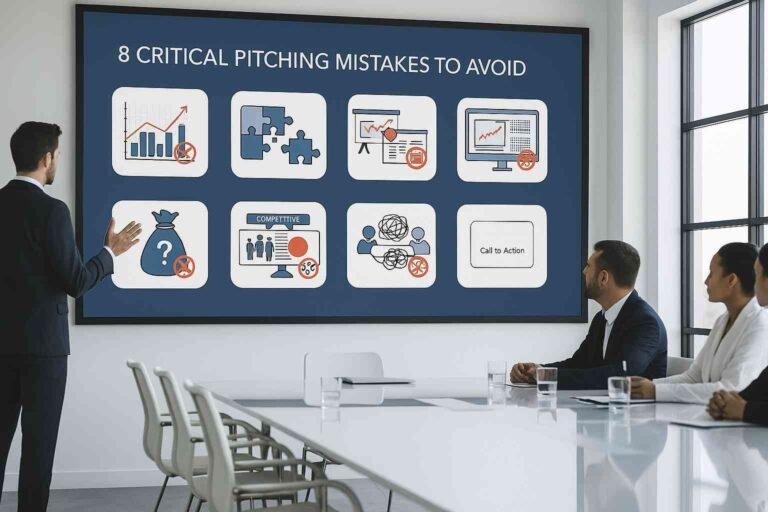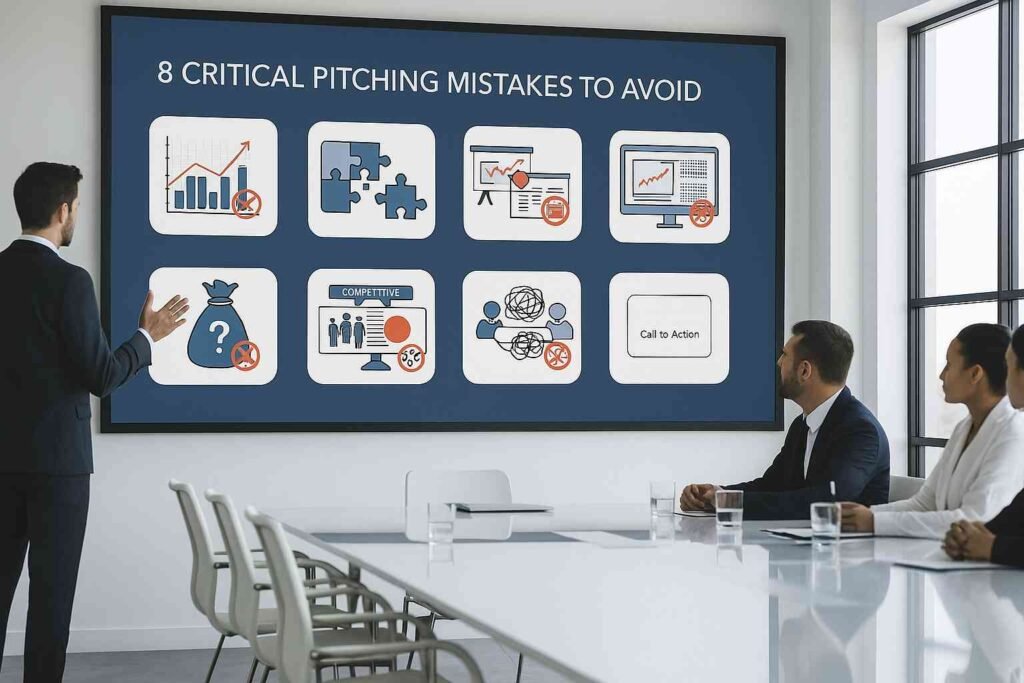Creating a good pitch deck is very important when you want to raise money or explain your business idea. But many people make it too long or too hard to understand. That is where the 10-20-30 rule comes in. This rule is very simple. It helps you make a pitch deck that is short, clear, and easy to follow. We will also show you why this rule works so well and how you can follow it step by step.
What is the 10-20-30 Rule?

The 10-20-30 rule was made popular by Guy Kawasaki, a well-known business expert. He said that a pitch deck should have:
- 10 slides only
- Take no more than 20 minutes to present
- Use a 30-point font size for all text
This rule helps you keep your slides simple and your message clear. It also makes your presentation easy to understand for investors and other people.
📊 Stat: Studies show that most investors spend less than 4 minutes looking at a pitch deck. So, keeping it short is very important.
Why This Rule Works So Well
When you try to say too much, people get confused. When you keep it short and simple, people remember what you said. The 10-20-30 rule helps in many ways:
- It saves time – You don’t waste time talking about small details.
- It keeps focus – You only share the most important things.
- It looks better – Big text and fewer slides make it easy to read.
- It builds trust – A simple pitch shows that you understand your own business.
✅ Simple pitch decks get more attention and are more likely to get a second meeting.
Step 1: Use Only 10 Slides

Why only 10 slides?
People can’t remember too much at once. If your deck has 30 or 40 slides, they will forget most of it. 10 slides is just enough to share all the key points.
What should the 10 slides be?
Here are the common 10 slides to include:
- Title Slide (Your name, company, and logo)
- Problem (What problem your business is solving)
- Solution (Your product or service)
- Business Model (How you make money)
- Market Size (How big is the opportunity?)
- Product Details (How it works)
- Competition (Who else is in the market?)
- Team (Who is building the business?)
- Financials (Your numbers and goals)
- Ask (How much money you need and what you’ll do with it)
✅ Keep one clear point on each slide.
Step 2: Present in 20 Minutes

Why 20 minutes?
A short and clear presentation shows that you respect your audience’s time. Many investors or decision-makers are very busy. If your pitch takes too long, they may lose interest or become tired. A 20-minute pitch helps you stay focused on what matters most. It also gives you time for questions and answers after your presentation, which is a good sign that they are interested in your idea.
Even if your meeting is 1 hour, you won’t have the full time to speak. There will be questions and discussion. So your pitch should take no more than 20 minutes.
How to stay within 20 minutes:
To make sure your pitch fits within 20 minutes, practice is key. Rehearse your talk many times. Time yourself to make sure you are not going over. Try to keep each slide short and direct. Don’t try to explain everything — only the most important parts.
- Practice your pitch again and again.
- Don’t read slides word for word. Just explain them.
- Keep each slide to 1–2 minutes.
- Use simple words so people understand quickly.
📉 Fact: If a pitch is too long, investors lose interest. They may stop listening or skip slides.
Step 3: Use 30-Point Font Size

Why 30-point font?
Big text helps your audience understand your slides better. If you use small font sizes, people in the back of the room or on smaller screens may not be able to read your slides. That creates confusion and reduces interest. A 30-point font size makes your presentation look neat, clean, and professional. It also forces you to write less, which helps you focus on the main idea.
If your text is too small, people won’t read it. Big text helps the audience read easily, even from far away.
Tips for using big fonts:
Big fonts keep your slides clean and easy to understand. They are useful for all types of audiences — even those with poor eyesight or people watching your presentation on a screen.
- Use 30-point or larger text size.
- Don’t fill slides with too many words.
- Use bullet points, not full paragraphs.
- Keep slides clean with lots of space.
✅ When your slides are easy to read, people will pay better attention.
Comparison Table: Long Pitch Deck vs. 10-20-30 Pitch Deck

| Feature | Long Pitch Deck | 10-20-30 Pitch Deck |
| Number of Slides | 25–40 slides | Only 10 slides |
| Time to Present | 30–45 minutes or more | 20 minutes |
| Font Size | Often too small to read | 30-point and easy to read |
| Attention Level | Low (too much info) | High (simple and clear) |
| Investor Interest | Less likely to continue | More likely to schedule follow-up |
Real Example: Why Simple Slides Work
In a real study, pitch decks that followed this rule or kept slides short had 3x more investor replies than those with very long decks. Investors want to see the big picture fast. If your message is clear, they will ask more questions. That means they are interested.
Best Practices to Follow the 10-20-30 Rule
- Focus on your story, not just the slides.
- Use one idea per slide.
- Use big, clear fonts and fewer words.
- Keep design simple. No need for too many colors or fancy styles.
- Practice until you can explain everything in 20 minutes.
✅ Simple slides + clear message = a strong pitch deck.
Final Thoughts
The 10-20-30 rule is one of the easiest and best ways to make your pitch deck strong. You only need 10 slides, 20 minutes to speak, and a big 30-point font for your text. It helps your audience stay focused and understand your idea clearly.
If you are planning to pitch your startup or idea, try this rule. It works well and shows that you respect the time of your audience.
If you want help in creating a clean and powerful pitch deck, you can work with a presentation design service. They know how to follow the 10-20-30 rule and make your message stand out. 🚀
FAQs
1. Can I use more than 10 slides?
Yes, but it’s better to keep extra slides as backup for Q&A. The main pitch should still follow the 10-slide idea.
2. What if I need more than 20 minutes?
Try to shorten your message. Only share the most important details. Leave time for questions.
3. Is 30-point font really needed?
Yes. Big fonts help people read quickly and stay focused. Smaller text makes slides harder to follow.
4. Will this rule work for all industries?
Yes! The 10-20-30 rule works for tech, finance, healthcare, and more. The goal is to stay clear and simple.
5. Can I get help to follow this rule?
Yes. A presentation design service can help you apply this rule and make your pitch deck look clean, simple, and professional.









